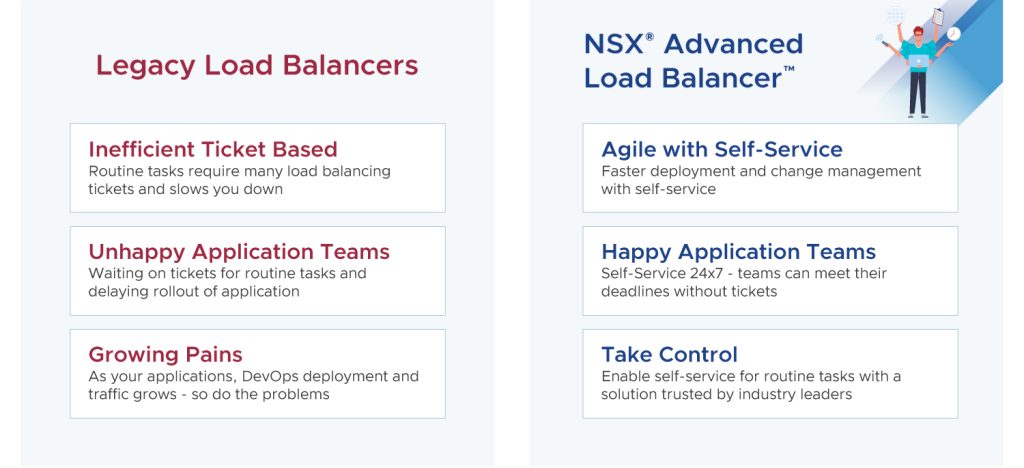In the fast-paced world of business where applications are key, efficiency and agility in delivery is critical. Legacy load balancers often fall short in meeting the demands of modern businesses. This blog introduces you to VMware NSX® Advanced Load Balancer™, a game-changing solution that empowers application teams to perform many routine load balancing tasks by themselves without resorting to a ticket system, taking up precious time from the infrastructure team. It also provides agility to deploy applications and make updates faster.
From Opening Tickets to Agile Self-Service for Routine Tasks
When working with legacy load balancers, provisioning a new Virtual IP (VIP) can be a time-consuming ordeal. It typically takes anywhere from days to weeks to get a new VIP up and running. This delay can hamper the agility of your development teams and hinder your ability to respond quickly to changing business needs. Additionally, most routine tasks, such as configuring new VIPs, adding capacity, or adding new servers to a load balancing pool, require submitting tickets, further exacerbating the delays.
Legacy load balancers are designed with operational dashboards for management rather than self-service orchestrators tools. They offer centralized management and analytics tools, but they lack self-service for application teams to automate and simplify their load balancing tasks themselves. Also, another challenge for legacy load balancers is setting guardrails around application team accesses and reducing impact radius.

VMware NSX Advanced Load Balancer has been meticulously designed to address these challenges and empower application teams. It offers a self-service portal that allows application teams to perform routine load balancing tasks with ease. Here’s how it stands out:
- Designed for Multi-Tenancy: The self-service portal is purpose-built for orchestration by multi-tenants, ensuring that each team can manage load balancing without interfering with others. This minimizes the risk of unintended disruptions.
- Strong and granular RBAC Controls: NSX Advanced Load Balancer offers extensive and granular RBAC controls. This means you can define precisely who has access to what, ensuring that the right individuals have the necessary permissions to manage load balancing tasks. This also limits the impact radius so misconfiguration by one team, does not affect other application teams. This is a key differentiation for NSX Advanced Load Balancer as it provides the confidence for resiliency for IT teams.
- Advanced features by default: NSX advanced Load balancer also can be enabled for many advanced features like progressive or slow-ramp rollout and least connect algorithm to empowers you Application and IT teams.
Make application teams happy by empowering them with self-service 24×7 to deploy on their own timeline with NSX Advanced Load Balancer.
From Living with Growing Pains to Taking Action Now
As your business grows so does the number of applications, DevOps practices, and traffic volumes. Your inefficiency also grows with legacy load balancers without self-service for application teams for routine load balancing tasks. In today’s hyper-competitive business landscape, delays and inefficiencies can be costly. Your legacy load balancers may have served you well in the past, but it’s time to step up your game.
- VMware NSX Advanced Load Balancer is the solution you need to harness the power of self-service load balancing for your application teams to achieve agility. It is a solution trusted by large enterprises worldwide, including many top financial institutions for self-service.
Act now and embrace the future of load balancing with VMware NSX Advanced Load Balancer! Speed up app deployment and get ahead of your competition.

Meet the Author
Pankaj leads product and solutions marketing and go to market strategy for NSX at VMware. He advises CIOs and business leaders for technology and business model transitions. In prior roles at Cisco and Citrix, he led networking, cybersecurity and software solution marketing.









